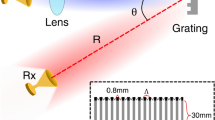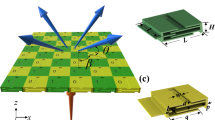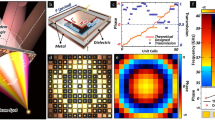Abstract
IT has been well established1,2 that, in the case of diffraction of light by very-high-frequency sound waves only the first order of diffraction appears in the field of view and it attains the maximum intensity when the sound wave-front is tilted to the corresponding Bragg reflexion angle. Any further tilt from this position results in gradual diminution of intensity and finally in the disappearance of the diffraction order. The angle over which the intensity of the diffraction order is distributed is called the ‘angular width of high-frequency diffraction’.
This is a preview of subscription content, access via your institution
Access options
Subscribe to this journal
Receive 51 print issues and online access
$199.00 per year
only $3.90 per issue
Buy this article
- Purchase on SpringerLink
- Instant access to full article PDF
Prices may be subject to local taxes which are calculated during checkout
Similar content being viewed by others
References
Rao, B. R., thesis, Andhra University (1948).
Rao, C. R., thesis, Osmania University (1953).
David, E., Phys. Z., 38, 587 (1937).
Rao, C. R., Nature, 193, 1169 (1962).
Author information
Authors and Affiliations
Rights and permissions
About this article
Cite this article
RAGHUPATHI RAO, C. Dependence of Angular Width of High-frequency Diffraction on Sound Wave-length. Nature 197, 677–678 (1963). https://doi.org/10.1038/197677b0
Issue date:
DOI: https://doi.org/10.1038/197677b0



